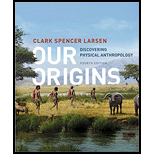
Concept explainers
Introduction: Primates, the group containing all species commonly related to lemurs, monkeys, and apes, are members of the biological order, and the latter category includes human beings.
Answer to Problem 1SQ
Correct answer: d. Rigidly connected, identical vertebrae in the backbone.
Explanation of Solution
Reason for the correct answer:
The species that live in and locomotes through the trees are referred to as arboreal adaptation. The primates have the characteristics of arboreal adaptations. The primates have immense diversity and they possess a distinctive body trunk. There are about five functional distinct types of vertebrae in the backbone of primates. The characteristic that is not shared by most of the primates is rigidly connected, identical vertebrae in the backbone.
Option d. is given as “rigidly connected, identical vertebrae in the backbone”.
Hence, the correct answer is option d.
Reasons for incorrect answers:
Option a. is given as “mobile joints, connecting bones of the shoulders, limbs, hands, and feet”.
Mobile joints, connecting bones of the shoulders, limb, hands, and feet are the characteristic features of the primates that make them good at living in trees. Therefore, option a is incorrect.
Option b. is given as “an opposable thumb and often an opposable big toe”.
The opposable thumb and big toe feature is the feature of primates that helps in arboreal adaptation shared by most of the primates. Therefore, option b is incorrect.
Option c. is given as “dermal ridges and flat nails on fingertips”.
The feature of dermal ridges and flat nails on the fingertips is shared by most of the primates in an arboreal adaptation. Therefore, option c is incorrect.
Hence, options a., b., and c. are incorrect.
The characteristic that is not an arboreal adaptation shared by most of the primates is provided.
Want to see more full solutions like this?
Chapter 6 Solutions
Our Origins: Discovering Physical Anthropology (Fourth Edition)
- The scientific name for the African rock python is Python sebae. Which name indicates its genus?arrow_forwardA divergence from ________ gave rise to tetrapods. a. ray-finned fishes c. cartilaginous fishes b. lizards d. lobe-finned fishesarrow_forwardDescribe three adaptations that allow for flight in birds.arrow_forward
- what are three bones that allows frogs to live on landarrow_forwardWhat did Neanderthals eat? What plants did they eat and what animals might they have hunted? A. Woolly rhinos, mammoths, straight tusked elephants B. Fruits, seeds and grasses C. Grubs and insects D. All of the abovearrow_forwardIn what ways did theropods differ from modern birds? Give at least two differences.arrow_forward
- Give a hypothesis about how bills, hunting methods, and legs aid birds in obtaining food. Give two detailed examples on the Cinnamon Teal and House Sparrow.arrow_forwardThe chelipeds of prawns are quite diminished in size when compared to crayfish and lobster.Hypothesize why you think these differences exist? Find some support for your hypothesis from the Internet or other scientific resource.arrow_forwardWhat can you infer about bats compared to other mammals? What do you conclude about the effect of hibernation on survival? What do you conclude about the effect of body mass on survival?arrow_forward
 Concepts of BiologyBiologyISBN:9781938168116Author:Samantha Fowler, Rebecca Roush, James WisePublisher:OpenStax College
Concepts of BiologyBiologyISBN:9781938168116Author:Samantha Fowler, Rebecca Roush, James WisePublisher:OpenStax College
 Biology (MindTap Course List)BiologyISBN:9781337392938Author:Eldra Solomon, Charles Martin, Diana W. Martin, Linda R. BergPublisher:Cengage Learning
Biology (MindTap Course List)BiologyISBN:9781337392938Author:Eldra Solomon, Charles Martin, Diana W. Martin, Linda R. BergPublisher:Cengage Learning



